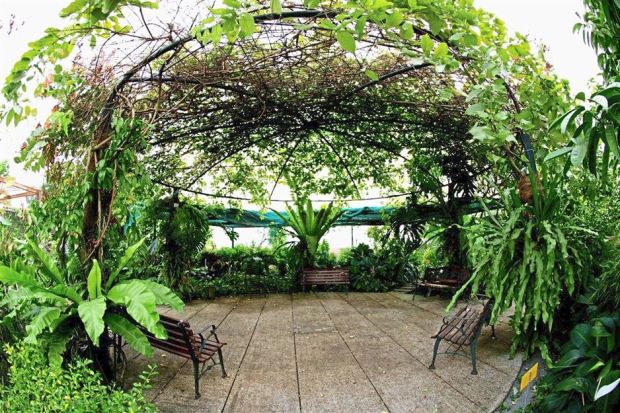BY JADE CHAN

One Utama Shopping Centres Secret Garden, perched on the rooftop of the seven-storey mall. — filepic
IMAGINE this – a rooftop garden with just a flat layer of grass, which, depending on the time and weather, is used for yoga, tai chi, a picnic or even social gatherings.
Known among experts as an “extensive green roof” system, it is a scheme that is easier to maintain compared to the “intensive green roof” system more commonly found in Malaysia.
“An extensive green roof has a very simple green cover like turf grass or ground cover,” said Institute of Landscape Architects Malaysia (Ilam) president Assoc Prof Dr Osman Mohd Tahir.
“It is easy to maintain, inexpensive, and has less requirements in terms of irrigation and fertilisation.”
He said the best local example of an extensive green roof is the Heriot-Watt University Malaysia building in Putrajaya, which has a living grass roof that also serves as an observation deck.
“An intensive green roof is like a mini garden on the roof.
“It has a lot of trees, shrubs and plants, so it’s more expensive to set up and maintain.
“While an intensive green roof is more functional and more pleasant to look at, an extensive green roof can be turned into a communal space if designed properly,” said Osman.
He noted that rooftop gardens were getting more popular, thanks to the increasing number of high-rise buildings and lack of space in urban areas.
“Under local laws, 10% of planning development has to be set aside as green space.
“The concept of landscaping previously referred to horizontal planting on the ground.
“However, with the lack of space, the trend has moved towards rooftop gardens and vertical green walls (using climbing or weeping plants),” added Osman.
This trend is categorised under “skyrise greenery”, which encompasses all greening within the building beyond ground level, including rooftop garden, vertical greening and terrace planting.
“As we move towards the Government’s target of being a developed country by 2020, people are favouring quality of living and quality of life as a lifestyle choice.
“The Taman Tugu project in Kuala Lumpur is something Ilam strongly supports as there is a need for a green lung in the city.

A worker removing plants from planting racks at a rooftop garden in Vancouver, Canada. With a 557.4sqm planting area, this farm can produce 68,039kg of vegetables every year. — filepic
“This also ensures that parks are conserved and preserved for the present and future generations.
“People who live in high-rise buildings also need to have their own green space, not just access to borrowed landscape, which is greenery outside their property,” said Osman, adding that beyond design, property developers were selling residential projects as a place to live, work and play.
Besides creating an aesthetically beautiful and more pleasant environment, he said having plants in and around buildings would help improve air quality, filter noise pollution, as well as reduce building energy consumption, stormwater run-off and urban heat island effect.
As plants play a vital role in reducing the “sick building syndrome,” Osman said those living in condominiums could still green their area despite the limited space.
“The National Aeronautics and Space Administration (Nasa) Clean Air Study lists some 20 house plants that are best for filtering air and removing certain kinds of toxic agents.
“Some examples include Lady Palm (Rhapis Excelsa), Snake Plant (Sansevieria Trifasciata) and Dragon Tree (Dracaena Marginata),” he said, adding that those plants could be kept in pots or planter boxes.
“Those with balcony space could consider using the hydroponics system to grow vegetables or flowers. Urban farming or permaculture could also be implemented for more sustainable living conditions,” he added.

The distinct living grass roof of Heriot-Watt University Malaysias Putrajaya campus offers natural ventilation, reduces thermal transmittance and doubles as an observation deck. — filepic
Osman, who is also the dean of Faculty of Design and Architecture at Universiti Putra Malaysia, felt more could be done on the rooftop garden concept in Malaysia.
“There is a need to have proper care and maintenance, as these green spaces are living things.
“For example, a vertical green wall has to be replaced every five to six years as that is its typical lifespan,” he explained.
“There is also a need for a good landscape management plan to ensure there is proper maintenance, and that the design and function of the garden continues to benefit users.”

















































